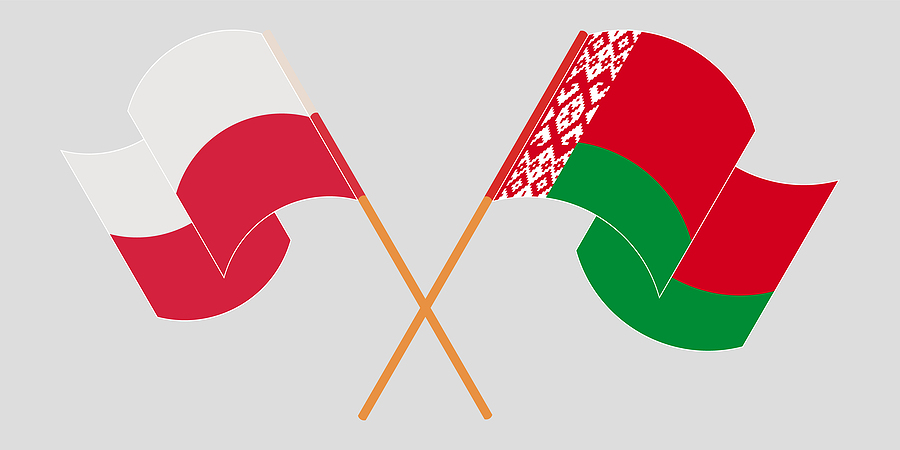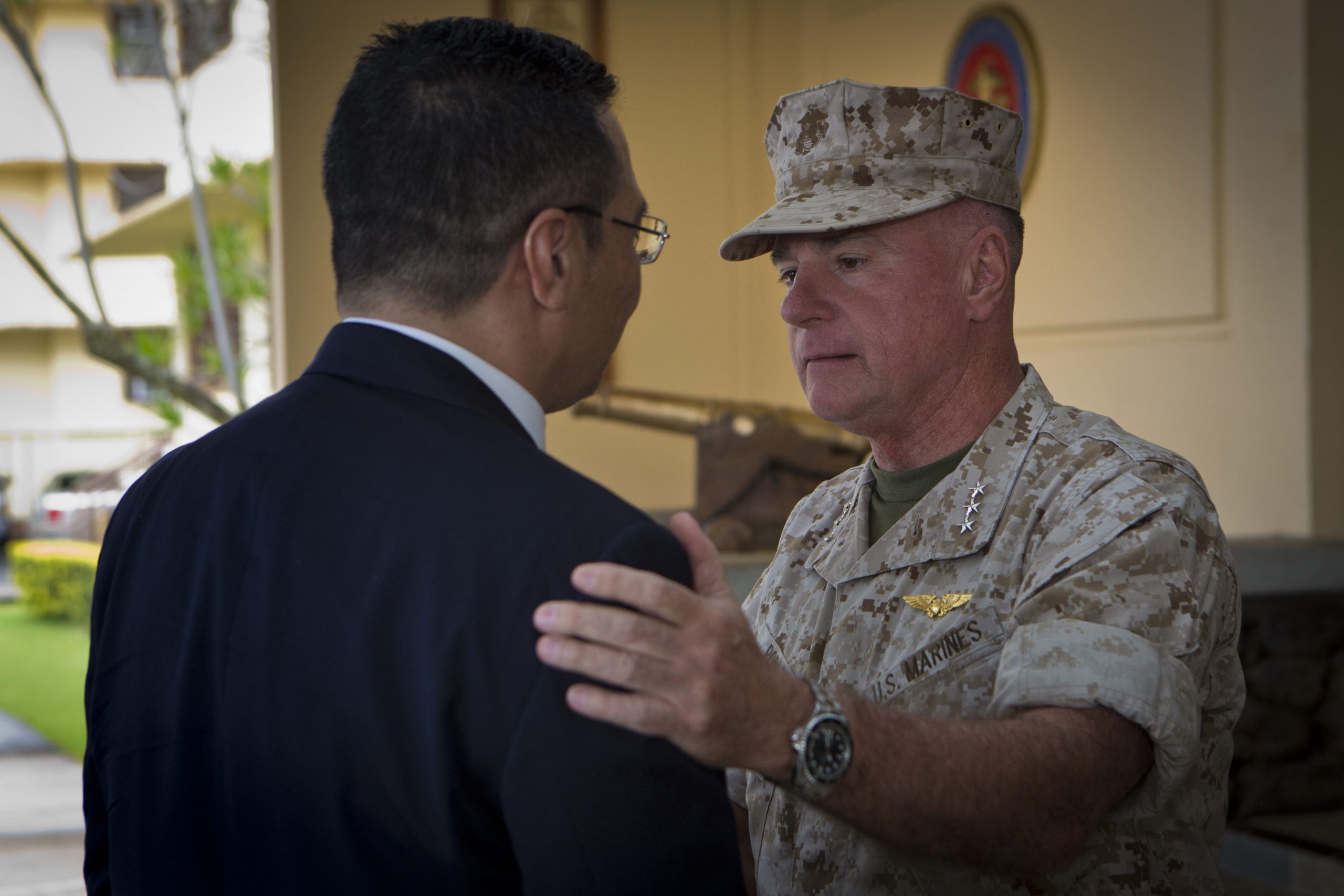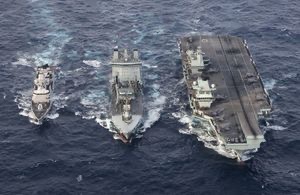By Robbin Laird
I had the chance to work with Lt. General (Retired) Robling both when he was Deputy Commandant of Aviation from 2011-2012 and when he was the MARFORPAC commander from 2012 to 2014.
We started by looking back at his time as the MARFORPAC Commander, and the beginning of the “pivot to the Pacific” and the challenges faced by the USMC at the time.
Question: Looking back, when you came to the Pacific command, the Osprey really was the key tool for USMC transformation in the region. In effect, it was the spear in the ground from which you built out a new way ahead. You also began the process of expanding the USMC relationship with Australia as well. How important was the Osprey in this transformation process?
Lt. General (Retired) Robling: The Osprey was transformational for us. There are 25,000 plus islands in the Pacific and half of the globe in the INDOPACOM theater. We were actually the main air-enabled ground force at the time in the region. The Army brigade was coming back from the Middle East to establish the Brigade on Oahu, and they tried their Pacific Pathways approach which failed miserably.
For us, the MV-22 opened the entire theater for us. We could air refuel the aircraft, we could island hop, and we could operate from Japan all the way to Australia. It was a game changer for how we approached theater operations and how the Joint Force Commander considered how he would use the Marines in the joint fight.
Question: Since you were there, and even though you were anticipating them, the F-35s are now operating in the theater. There are now two squadrons of Marines operating from Okinawa and they are operating every day in the first island chain. That is a big change from when you are there, and how would describe that change?
Lt. General (Retired) Robling: It is a big change. Most importantly the Marines flying the F-35 will support the USAF’s initial air campaign in any Korean contingency. This will give the Joint Force Commander unprecedented stealth capability until the rest of the joint force can close on the region.
Secondly, the F-35’s will support our partners and allies in the region by training and operating off of the ships in the 31st MEU.
The F-35’s ability to operate together and to distribute data to the joint force and operate in concert with the MV-22’s have simply expanded how we operate in the Pacific and how the Joint Force Commander looks at the role of the Marines and their contribution to the joint force. Combing the two provides a unique airborne capability in the Pacific which can deliver force insertion throughout the region at significant speed and range.
Question: When I visited you in Hawaii during your time as MARFORPAC Commander, you and your staff were clearly focused on what you saw as an upsurge in “amphibiosity” with regard to our allies. Significant progress has been achieved along these lines since 2014. How should we view this progress?
Lt. General (Retired) Robling: We were especially focused on Japan and Australia and since that time both nations have augmented their amphibious capabilities. We helped those nation’s to think differently about warfighting and how to defend their interests.
For example, with the both the MV-22 and the F-35B operating from amphibious ships, the Japanese can think differently with regard to defending their outlying islands and, more generally, about the defense of Japan. The three – MV-22s, F-35Bs, and amphibious aviation ships – are transformational for both the USMC and our allies.
Question: For the USMC, the recent transformation process started in 2007 with the coming of the MV-22. Now General Berger, the current USMC Commandant, is adding a new chapter with regard to the next transformation module for the USMC. How should we understand the approach and how does it blend in with what has come before?
Lt. General (Retired) Robling: I believe the Commandant was courageous in getting out ahead of the Joint force in facing what everyone is calling the pacing threat; China. Our nation has to face that threat and decidedly prepare for it now. But the challenge is that he is out in front of the other services in their preparation for a fight with China. I do not believe we as a country have decided what the strategy or that fight might look like and we don’t have a full understanding of China’s improved war fighting capabilities, how they will use them, how we will counter them, or what the USMC’s role should be in that fight.
Question: The approach to building a more distributed USMC is certainly in line with past USMC practice, but the challenge is to ensure force cohesion and force integrability, first with regard to a deployed MEU or MAGTF, and with whatever joint or coalition partners are working with that distributed USMC force. How do you see the challenge of distribution and integration?
Lt. General (Retired) Robling: The danger here is that we develop a niche force incapable of participating in high-end fights operating as some type of reconnaissance role or rear area security operation. In an escalatory war with China, I don’t believe it would be long before North Korea starts looking seriously about taking South Korea and likely encouraged to do so by China.
As a previous III MEF Commander and later MARFORPAC commander, I would argue that the Marine Corps’ unique aviation and amphibious capabilities give it a decided advantage to the Joint Force Commander in other near peer campaigns. The redesigned force as envisioned by the Commandant will not necessarily support those type of activities.
While we work towards becoming a light force focused on forward positioning and persistent inside the weapons engagement zone activities, we do not have the kind of sensors which are needed for this type of operation. As a force that will collect and distribute data back to the joint force, we are woefully incapable of doing so much less operate low signature bases with low signature force structures.
This requires the right kind of C2, ISR accessibility, strike support, logistical support and an ability to be inserted and extracted at the time of our choice. C2 will not be persistent, and neither will data transmission capabilities. We need a networked force that can operate even when we are not always tied into the joint force.
Logistical support is another weakness in our development of EABO operations that seriously needs overhauling. The Navy will likely need to prioritize their missions in full spectrum crisis management operations against China. Logistical support to small units of Marines on obscure islands will likely fall out of that their decision mix and the commercial capabilities to support the force in a maritime centric China fight will be sorely inadequate.
The Commandant posed this weakness himself in remarks at the recent Marine Corps Aviation Symposium where he stated in the case of limited logistical support, the Marines may have to resort to foraging. How long can we forage on a pacific island?
I do believe however, that the Commandant is correct in his vision of investing in HIMARS and Maritime Strike Missile (both long and short range) to help in anti-access and aerial denial operations. These rockets and missiles are game changers and can significantly advance the Marines war fighting capabilities both in limited maritime and extended land operations.
I concur with the Commandant that the MAGTF cannot be the Marines only solution in warfighting operations. Yet we are building a force now that decidedly understates the role of aviation in all our warfighting activities. Both in EABO operations and in our role in near peer conflict.
Over the last thirty years we have developed and acquired MV-22, CH-53, and F-35 aircraft with significant capabilities not otherwise brought to the joint force. This aviation triad has increased our value to the Joint force tenfold. It has made the Joint warfighting commander think differently how he will prosecute a campaign because of our decided advantage this triad of aviation capabilities alongside our Marines gives us.
Aviation cuts in constrained budget environments (we have always been in constrained budget environments) is inevitable, but once again, we must ensure the cuts are not so deep that we cannot recover from them if we are wrong about our role in the Indo-Pacific fight. We may be.
China may not care that Marines will be rooting around on islands inside the Second Island Chain. If our purpose is to be part of a naval force capable of ensuring sea control and denial operations, China may have already taken those considerations into their war fighting equation.
If I am right, then we need to give them pause to change their equation so our presence actually does what we say it will do. While I applaud the Commandant’s focus on returning to our core mission of support to the Naval Fleet Commander through our role as the Fleet Marine Force Commander, our ability to work with the Navy in an ecosystem that requires insertion and support to focus inside the weapons engagement zone is not there now and will not likely be for quite some time.
This will take a larger investment by the Navy in capabilities and training that they have so far been unwilling to invest.
Featured Photo: Datuk Seri Hishammuddin Hussein, Malaysian Minister of Defence, and U.S. Marine Corps Lt. Gen. Terry G. Robling, commander, U.S. Marine Corps Forces, Pacific, greet one another on Camp Smith, Hawaii, April 1, 2014. Hishammuddin is visiting Hawaii for a meeting with the Honorable Mr. Chuck Hagel, U.S. Secretary of Defense, and other defense ministers from the Association of Southeast Asian Nations, April 1-3. (U.S. Marine Corps photo by LCpl. Wesley Timm/Released)





